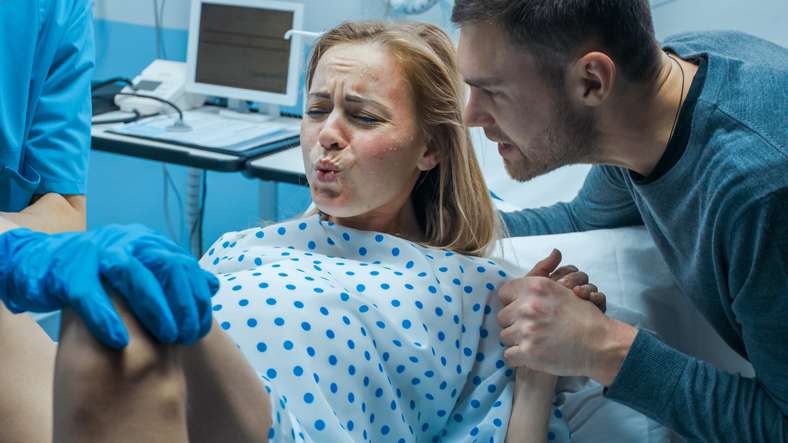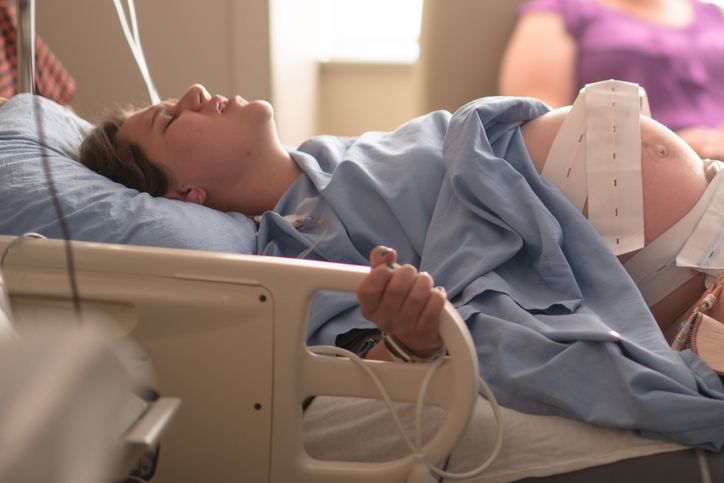Perineal Trauma in Childbirth: Recovering from Vaginal Tears

Labor pain and postpartum trauma from childbirth are common experiences for many women after giving birth. One of the most painful types of childbirth injury is perineal trauma or vaginal tearing.
Perineal trauma occurs when the skin between the vaginal opening and the anal sphincter tears.
Perineal tears are common during vaginal birth. They affect an estimated 80 to 85 percent of women (Jansson, 2020; Webb, 2014). The injury can be minor, moderate, or serious.
What are the different types of perineal trauma? How can you work to prevent it? And what are the best ways of caring for your perineal area after birth?
Related: 9 Natural Labor Pain Relief Techniques
What is Perineal Trauma in Childbirth?
Perineal trauma is an injury to the perineum, that is, the area between the vaginal opening and the anus. Perineal trauma can also refer to a vaginal tear or an injury to the clitoris or labia.
Around 70% of perineal trauma requires suturing after birth (Webb, 2014). Around six percent of women will experience later complications, such as infection and re-opening of the wound.
Long-term consequences of severe perineal trauma may include urinary and fecal incontinence, sexual dysfunction, postnatal depression, and prolapse of the pelvic organs.
Is an Episiotomy Considered Perineal Trauma?
An episiotomy is a deliberate cut to the perineal area to make room for the emerging baby. An obstetrician may perform a midline episiotomy if the baby needs to be born quickly, if the patient is at risk for serious vaginal tears, or if an instrument, such as forceps or vacuum extraction is to be used (RCOG).
While an episiotomy does injure the perineal area, its main purpose is to prevent worse injury.
What Causes Perineal Trauma?
Perineal trauma can occur when the vagina stretches during a vaginal delivery to accommodate the baby’s head. Tears typically occur during the second stage of labor, when the baby is emerging. Injuries can also occur inside the vagina, to the clitoris, and on the labia.
The use of forceps can cause perineal trauma, as can the use of vacuum extraction (Jansson, 2020). Large babies can also increase the likelihood of perineal tears and trauma.
Different Degrees of Perineal Tears

Perennial tears can range from mild to severe. Obstetric science divides perineal lacerations into four categories according to the severity of the tears. These are known as the four degrees of perineal tears.
First-Degree Tears
First-degree perineal tears are minor, skin-level injuries. First-degree tears can affect the perineum, vagina, clitoris, or labia.
These generally heal quickly on their own. Complications are rare, but first-degree tears can be very painful.
Second-Degree Tears
Second-degree tears affect both skin and muscle in the perineal area. Like first-degree tears, second-degree tears are unlikely to cause long-term issues. However, they, too, can be quite painful.
About 50 percent of perineal tears affect the surrounding muscles. Vacuum extraction is a major cause of second-degree tears.
Generally, a doctor will treat a second-degree tear with stitches. This is done under local anesthetic.
Third-Degree Tears
Third-degree tears require surgical repair and under four percent of birthing mothers
These tears are more serious, and affect the muscle of the perineum and the anal sphincter (the muscle that controls the anus). They are also known as obstetric anal sphincter injuries.
Fourth-Degree Tears
A fourth-degree tear is a very severe tear. A fourth-degree tear affects the anal sphincter, and sometimes the rectum (the part of the lower intestine that ends at the anus).
In some rare cases, a rectal buttonhole can open. This is a hole between the wall that separates the rectum and the vagina.
Fourth-degree tears require surgical repair.
Complications of Perineal Trauma
Perineal trauma can result in a variety of short-term and long-term complications.
Short-term complications from minor tears can include infection, soreness, and re-opening of the original wounds. These generally heal on their own.
Breastfeeding may also be impacted if the wounds cause too much pain to sit comfortably to feed, or if the injuries require antibiotics or pain medication.
Urinary and anal incontinence is one of the most distressing complications of perineal trauma. One medical study showed that second-degree tears are a risk factor for later stress incontinence, while OASI injuries are a risk factor for urge incontinence. OASI injuries are also the leading cause of anal incontinence in women.
- 38 percent of women in the study also reported dyspareunia or sexual dysfunction.
- 63 percent of women in this study reported that their OASI injuries continued to affect their daily lives one year after delivery.
- OASI injuries also increased the risk of pelvic organ prolapse, pelvic pain, and a variety of pelvic floor disorders.
Who is At Risk for Perineal Tearing?
There are a number of risk factors for perineal tearing and OASI.
- People giving birth for the first time are at greater risk for perineal trauma than people who have previously given birth.
- Younger maternal age is also associated with greater trauma risk.
- A family history of pelvic floor dysfunction and/or connective tissue deficiency increases the odds of perineal trauma
- Women who have undergone female genital mutilation (FGM) are at greater risk for perineal tearing during childbirth.
- Epidurals are also linked to a higher chance of perineal trauma during childbirth, as are episiotomies.
- If the second stage of labor is longer than usual, this can increase the risk of perineal trauma.
- Babies in the occiput-posterior position at birth (head down, facing toward the mother’s belly button) also increase the risk of perineal tearing.
- Shoulder dystocia — when the baby’s shoulder gets caught on the mother’s pubic bone during delivery—can also cause perineal trauma.
- Babies with a higher birth weight (over nine pounds or four kilograms) are also more likely to cause perineal tearing during delivery.
- A larger baby’s head at birth (over 13.7 inches or 35 centimeters in circumference) likewise increases the chances of tearing.
- The use of vacuum extraction or forceps during delivery increases the chances of perineal trauma, particularly second-degree tears.
- Post-term delivery (after 42 weeks of gestation) is also associated with a higher risk of perineal trauma.
Preventing Perineal Trauma During Childbirth
Fortunately, there are some interventions that you can do to reduce your risk of intrapartum perineal trauma (RCOG).
Perineal Massage
From 34 weeks of gestation onward, perineal massage can help to loosen the muscles to ease delivery. You can perform the massage on yourself, or with a partner once or a few times a day.
- First, sit in a warm bath to relax the muscles around the perineum.
- Next, lie down on your back, with your knees up and your back supported with pillows.
- Use a lubricant such as a vitamin E oil, olive oil, almond oil, or a personal lubricant. Make sure that your fingernails are cut short to avoid cuts and scratches.
- Place your thumbs inside the vagina, between one to one and a half inches. Use your thumbs to press against the back wall of the vagina, toward the anus. Press gently but consistently until you feel the muscles stretch.
- Hold the stretch for one to two minutes.
- Continue the stretch, moving slowly outward and inward in a U-shaped motion.
Birth Positions
Giving birth while kneeling, on all fours, or lying on your side can help to reduce the chance of perineal tearing (RCOG). Speak with your delivery specialist about the best birthing position for you.
Warm Compress
Placing a warm compress on the perineal area during birthing can also reduce your chances of injury.
“Hands-On” Birth
Manually supporting the perineal area during birth can also help to decrease the likelihood of perineal injury (RCOG).
Postpartum Perineal Care and Recovery After a Perineal Tear
Most minor perineal tears will heal on their own. Second-degree tears are generally sutured after delivery, while third- and fourth-degree tears require surgical repair.
In the event of severe tears, your doctor will give you specific post-surgical care instructions. If your tears are minor, however, your doctor may recommend a combination of the following.
You may be prescribed pain relief medication or recommended an over-the-counter medication like aspirin.
Laxatives can help to prevent constipation. This, in turn, can help to keep wounds from reopening. Eating a high-fiber diet rich in fruits and vegetables can also help to keep stool soft and prevent constipation.
Other postpartum perineal care advice to ease pain include:
- Applying warm compresses or ice packs to painful areas
- Sitting on a pillow or a padded ring to make sitting less painful
- Taking sitz baths (warm, shallow baths) can also ease perineal pain.
If you have questions or concerns, speak to your healthcare provider.
When to Seek Medical Attention
If you have minor postpartum tears, your healthcare provider will check on your recovery at your scheduled postpartum appointments.
However, if you experience any of the following, it’s important to contact your healthcare provider immediately.
- Severe pain
- Pain that gets worse
- Pain that won't go away
- Fever
- Leaking urine
- Leaking stool
Be Prepared for Postpartum Recovery
Perineal trauma sounds frightening, and it can be serious. However, only a small percentage of women experience severe trauma. And with proper precautions, you can decrease your chances of tears and trauma.

